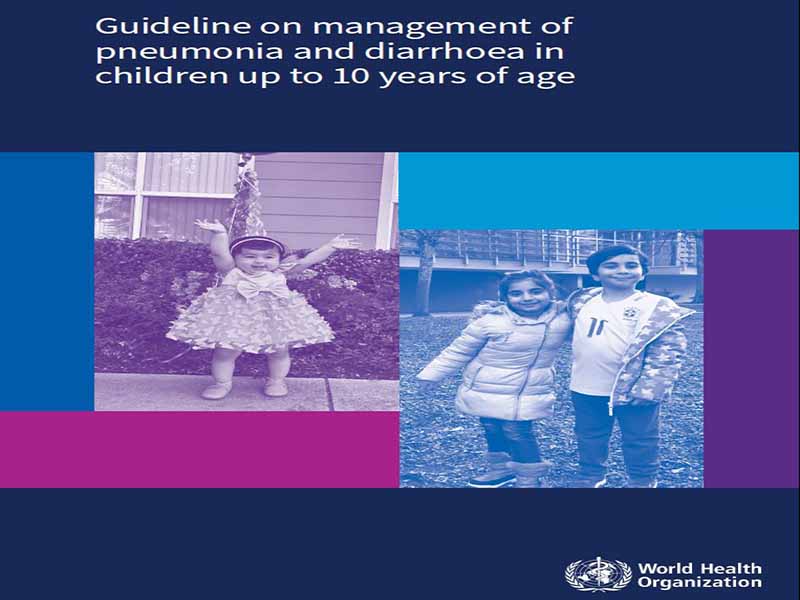- عنوان کتاب: Guideline on management of pneumonia and diarrhoea in children up to 10 years of age
- نویسنده: World Health Organization
- حوزه: پزشکی اطفال
- سال انتشار: 2024
- تعداد صفحه: 80
- زبان اصلی: انگلیسی
- نوع فایل: pdf
- حجم فایل: 2.79 مگابایت
ذات الریه و اسهال 23 درصد از مرگ و میر کودکان زیر پنج سال را تشکیل می دهند و مسئول حدود 1.17 میلیون مرگ در کودکان زیر پنج سال در جهان هستند. علاوه بر این، ذات الریه و اسهال مسئول 18 درصد مرگ و میر در کودکان 5 تا 9 ساله بوده که منجر به تخمینی 86000 مرگ قابل پیشگیری در سراسر جهان در سال 2021 شده است. عمدتاً بر روی کودکان کمتر از 5 سال متمرکز شده است. WHO راهنمایی بالینی در مورد مدیریت این شرایط در کودکان 5 تا 9 ساله ایجاد نکرده است، که در پاسخ به درخواستهای سیاستگذاران و تصمیمگیرندگان ملی، شکافی برطرف شده است. با توجه به این وضعیت، و همچنین تغییر مشخصات اپیدمیولوژیک و جمعیت شناختی کشورها، درک بالینی پیشرفته پیشگیری و مدیریت پنومونی و اسهال، و معرفی مداخلات جدید، یک بازنگری پیشرفته از دستورالعمل های موجود انجام شده است. عقب افتاده هدف این راهنما توسعه، بهروزرسانی و تجمیع توصیههایی در مورد مدیریت پنومونی و اسهال به منظور اطلاعرسانی، بازنگری یا بهروزرسانی توسعه پروتکلهای بالینی برای مدیریت پنومونی و اسهال در کودکان تا 10 سال است. هدف این دستورالعمل کمک به کشورهای عضو سازمان جهانی بهداشت و شرکای آنها در تصمیم گیری مبتنی بر شواهد در مورد اقدامات مناسب در تلاش برای رسیدگی به بیماری های رایج دوران کودکی از جمله ذات الریه و اسهال است. روند بهروزرسانی دستورالعملهای موجود در سال 2020 آغاز شد و با انتصاب یک گروه توسعه دستورالعمل (GDG)، مشاوره، توسعه سؤالات کلیدی در قالب جمعیت، مداخله، مقایسه و نتیجه (PICO) و تولید بررسی های سیستماتیک برای پاسخ به این سوالات. همه مراحل با استفاده از رویکرد ارزیابی و ارزیابی توصیهها (GRADE) از مواردی که در کتاب راهنمای WHO برای توسعه دستورالعملها ذکر شده است، پیروی کردهاند. از طریق این فرآیند، از جمله بحثهای گسترده که تا دسامبر 2023 ادامه یافت، GDG با توصیههایی برای ذاتالریه نشاندادهشده در جدول 1، و برای اسهال نشاندادهشده در جدول 2 موافقت کرد. تغییرات اصلی نسبت به توصیههای قبلی شامل ارائه دامنه وسیعتر برای درمان پنومونی در سطح جامعه، استفاده از مجموعهای از علائم و نشانهها برای تشخیص هیپوکسمی در زمانی که پالس اکسیمتری در دسترس نیست، و یک دوز جدید برای مکمل روی (به تغییرات قابل توجه توصیهها مراجعه کنید). هر بخش). مسائل مربوط به مقاومت آنتی بیوتیکی با توجه به نگرانی های فعلی جهانی در مورد نظارت آنتی بیوتیک در تمام بحث های مربوطه در نظر گرفته شد. برخی از آنتی بیوتیک های در نظر گرفته شده در لیست نظارت WHO’s AWARE هستند.
Pneumonia and diarrhoea account for 23% of under-five mortality and were responsible for an estimated 1.17 million deaths in children under five globally. Furthermore, pneumonia and diarrhoea were responsible for 18% of mortality in children 5–9 years of age, resulting in an estimated 86 000 preventable deaths globally in 2021. Existing World Health Organization (WHO) guidance on the clinical management of pneumonia and diarrhoea has mainly focused on children less than 5 years of age. WHO had not developed clinical guidance on the management of these conditions in children 5–9 years of age, which is a gap being addressed in response to calls from national policy- and decision-makers.
Given this situation, as well as the changing epidemiologic and demographic profiles of countries, the enhanced clinical understanding of prevention and management of pneumonia and diarrhoea, and the introduction of new interventions, a state-of-the-art review of existing guidance had been overdue.
The goal of the guideline is to develop, update and consolidate recommendations on the management of pneumonia and diarrhoea in order to inform, revise or update the development of clinical protocols for the management of pneumonia and diarrhoea in children up to 10 years of age.
This guideline aims to help WHO Member States and their partners make evidence-informed decisions on the appropriate actions in their efforts to address common childhood illnesses, including pneumonia and diarrhoea.
The process of updating the existing guidance began in 2020 and was followed by the appointment of a Guideline Development Group (GDG), consultations, development of key questions in Population, Interven-tion, Comparator and Outcome (PICO) format, and the production of systematic reviews to answer those questions. All steps have followed those laid out in the WHO Handbook for guideline development, using the Grading of Recommendations Assessment and Evaluation (GRADE) approach.
Through this process, including extensive discussions continuing into December 2023, the GDG agreed on the recommendations for pneumonia shown in Table 1, and for diarrhoea shown in Table 2.
The main changes from previous recommendations involve giving greater scope for pneumonia treatment at the community level, using a specific set of signs and symptoms to diagnose hypoxaemia when pulse oximetry is not available, and a new dose for zinc supplementation (see significant changes to recommendations in each section).
Antibiotic resistance issues were taken into account in all relevant discussions, given current global concerns about antibiotic stewardship. Some of the antibiotics considered are on WHO’s AWARE watch list.
این کتاب را میتوانید از لینک زیر بصورت رایگان دانلود کنید:
Download: Guideline on management of pneumonia and diarrhoea in children up to 10 years of age




































نظرات کاربران